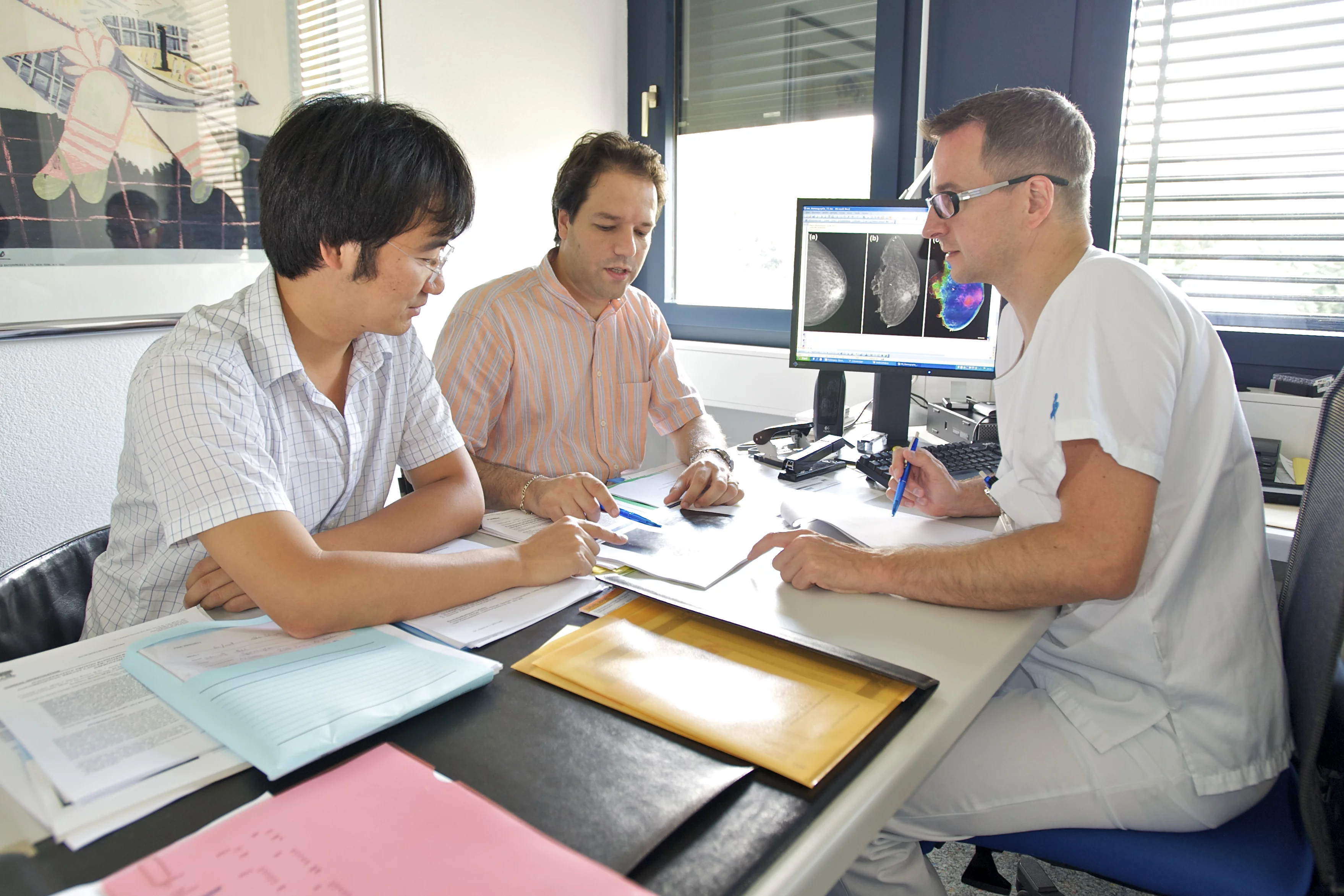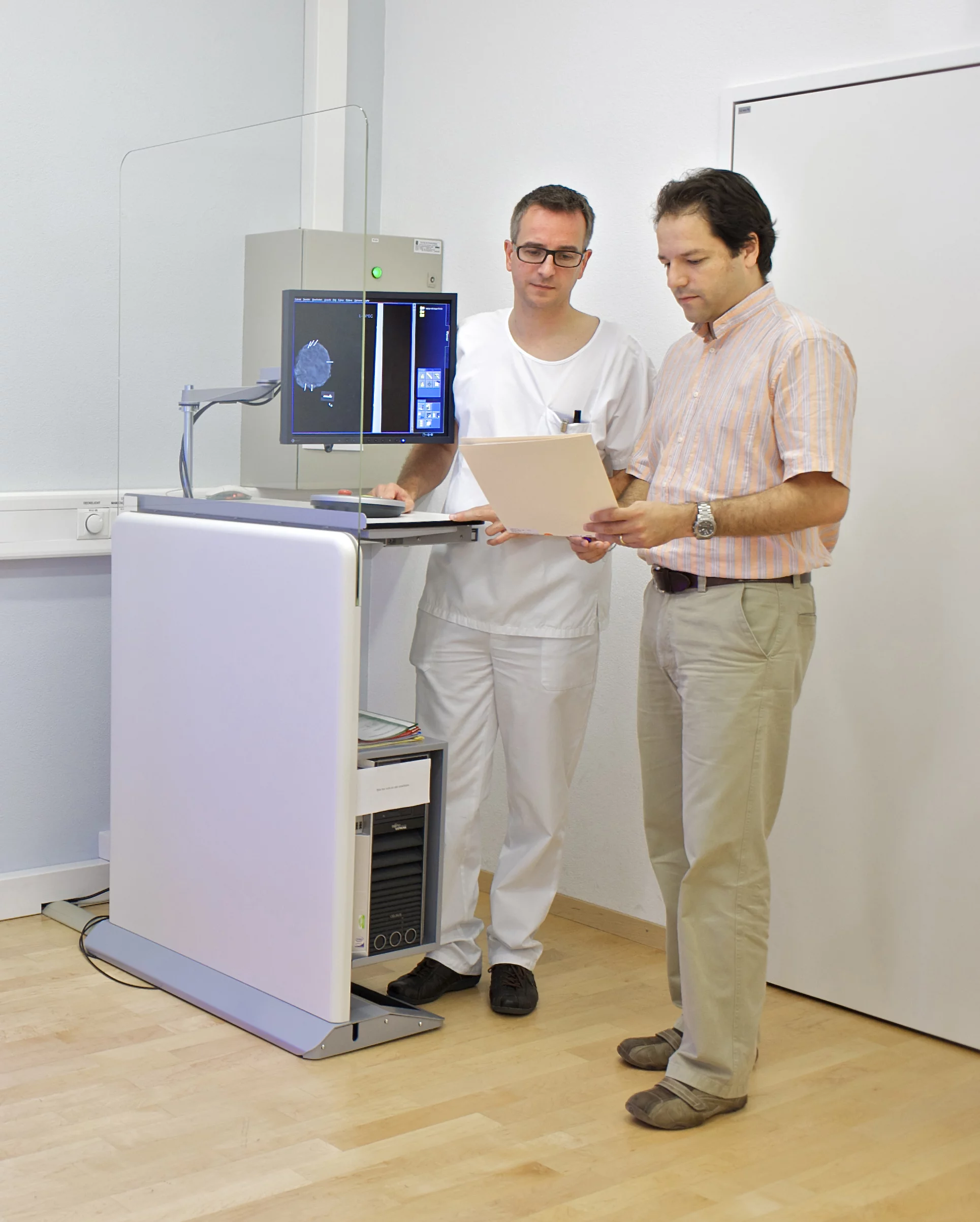Collaboration between research, hospital and industry aimed at transferring innovative procedure into daily practice.
The Paul Scherrer Institute (PSI) has developed a new breast cancer diagnostic method, and is now carrying out first tests on non-preserved human tissue in conjunction with the Kantonsspital Baden AG. This new method should be able to reveal structures that cannot be seen using conventional mammography. Standard procedures only determine the extent to which X-rays are attenuated by various tissue structures. In contrast to this, the new method also makes use of the fact that X-rays actually consist of waves, and that their properties change slightly as they travel through tissue. These changes are now measurable and can contribute to the creation of a more meaningful image of the object under investigation. Scientists from the research department at Philips are currently investigating the use of this process as the basis for application in medical practice, and in mammography in particular. The researchers have reported on their results in the online edition of the Investigative Radiology journal.
The aim of any mammography investigation is to detect tumours in the female breast as early as possible, so that treatment can start in good time. A good mammography procedure is therefore expected to recognise as many tissue changes as possible and to distinguish tumour tissue clearly from any other tissue. At the same time, the radiation dose administered during the investigation must be kept as low as possible.
Tests under realistic conditions
Researchers at the Paul Scherrer Institute have developed a procedure that should provide these benefits. Working with doctors from the Kantonsspital Baden (KSB), they have now succeeded for the first time in generating images of tissue that originated from breast surgery but had not been preserved. This approach produces an extremely close approximation to the situation in which an actual investigation is carried out on human beings. For example, we could use this new process to distinguish scars from tumour tissue and identify extremely small cancer nodules, of a size never yet identified by current investigation techniques
, said Dr. Nik Hauser, director of the certified breast centre at the Kantonsspital, who led the project on the medical side. A clinical study is currently underway, and should prove the advantages of the new method using a larger group of patients. In particular, doctors who did not take part in the development of the method are required to make an independent assessment of the advantages of the new images in comparison with those obtained from conventional X-rays.
Method developed at the Paul Scherrer Institute
In this new procedure, X-rays pass through the breast in exactly the same way as in conventional mammography. However, a normal X-ray image can only determine how much of the beam has been retained by the tissue – basically, an X-ray image just shows the shadow cast by the object under investigation. However, X-rays also undergo another subtle change as they travel through an object. Physically, X-rays are electromagnetic waves and, as they pass through various tissue structures, the direction of the waves undergoes slight changes – a similar effect to that shown by water waves hitting a pier in a harbour. We at the Paul Scherrer Institute have spent years developing methods for investigating these changes and interpreting the information they contain, so that we can create the basis for new investigative methods to be used in medical and materials research
, explained Marco Stampanoni, Professor at the Institute for Biomedical Engineering at the University and ETH Zurich and director of this project at PSI. One particular feature of the phase-contrast method used in this process is the three extremely fine gratings through which the X-rays have to pass – one in front of the object under investigation and the other two located behind it. The various components of the light waves interact with each other here in such a way as to provide the required information. The X-rays are generated in a tube that is essentially the same as an X-ray tube used in normal, everyday clinical practice.
The next goal: A prototype for use in practice
The long-term aim of this work is to develop a novel piece of equipment that can be used for regular routine breast examinations in clinical practice, and deliver improved images of breast tissue – at a significantly lower cost than techniques such as computer tomography or magnetic resonance imaging. Philips has been brought into the project as an experienced partner in the field of healthcare. The potential of this method is defined on the one hand by the innovative nature of the measured information, but on the other hand is also characterised by the use of conventional technologies that are widely applied in medical technology to generate and detect X-rays. Our declared goal is to use the example of mammography on humans beings to conclusively demonstrate the clinical benefits
, explained Ewald Rössl, project manager for this research work at Philips.
Approved by the Institutional Review Board
This study used tissue obtained from people who had just undergone surgery. The individuals in question gave their written consent to the use of their tissue and the study was approved by the local Institutional Review Board at the Kantonsspital Baden.
About the KSB
The Kantonsspital Baden provides basic medical care for 150,000 local residents, together with more extensive and specialised care for about 300,000 inhabitants of the eastern part of Canton Aargau. It treated 18,000 in-patients and more than 65,000 out-patients in 2010. The KSB has a turnover of CHF 269 million, with a workforce of 1750 staff and 209 trainees.
Contact
Original publication
-
Stampanoni M, Wang Z, Thüring T, David C, Roessl E, Trippel M, et al.
The first analysis and clinical evaluation of native breast tissue using differential phase-contrast mammography
Investigative Radiology. 2011; 46(12): 801-806. https://doi.org/10.1097/RLI.0b013e31822a585f
DORA PSI
About PSI
The Paul Scherrer Institute PSI develops, builds and operates large, complex research facilities and makes them available to the national and international research community. The institute's own key research priorities are in the fields of future technologies, energy and climate, health innovation and fundamentals of nature. PSI is committed to the training of future generations. Therefore about one quarter of our staff are post-docs, post-graduates or apprentices. Altogether PSI employs 2300 people, thus being the largest research institute in Switzerland. The annual budget amounts to approximately CHF 450 million. PSI is part of the ETH Domain, with the other members being the two Swiss Federal Institutes of Technology, ETH Zurich and EPFL Lausanne, as well as Eawag (Swiss Federal Institute of Aquatic Science and Technology), Empa (Swiss Federal Laboratories for Materials Science and Technology) and WSL (Swiss Federal Institute for Forest, Snow and Landscape Research). (Last updated in June 2025)


